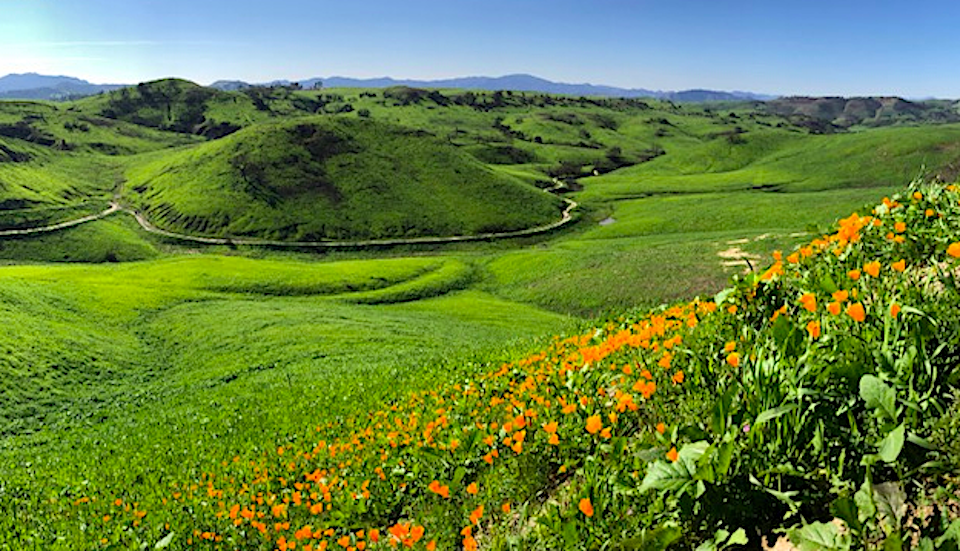
There could be a spectacular bloom of wildflowers coming to Santa Monica Mountains NRA this spring/NPS file
There aren't a lot of upsides to wildfires, not for human society, but they do serve landscapes well by converting downed trees and other vegetation into soil nutrients. If the weather cooperates, in terms of rainfall, they can lead to spectacular floral displays, which is something that could be coming soon to Santa Monica Mountains National Recreation Area in California.
The NRA was badly burned last fall by the Woolsey Fire, but recent steady rains could prove to be the perfect additive to spour a promising display of spring wildflowers in the Santa Monica Mountains during the peak flowering season that typically occurs in March and April.
“We are expecting a very good showing because of the fire,” said Mark Mendelsohn, a National Park Service biologist at Santa Monica Mountains. The team of biologists is vigilantly keeping an eye out for new sprouts during #WildflowerWatch2019.
Mendelsohn said one specific aftereffect of the destructive Woolsey Fire will be the blooming of “fire follower” herbaceous plants. These species normally bloom only after a fire, and there are more than 100 of these types of plants.
The rain storms - in some cases multiple storms that pounded the area in the span of one week - began in October and came at just the right time and in just the right amount. Biologists say these rains will also play an important role in the predicted bloom. At a weather recording station in Cheeseboro, Ranch, 14.17 inches of precipitation has been recorded for this season, thus far. Last year, 1.95 inches of rain had fallen by this time - a marked difference!
Park staff have reported seeing California poppies (Eschscholzia californica), blue dicks (Dichelostemma capitatum), shooting stars (Primula clevelandii), lemonade berry (Rhus integrifolia), lupines, and wild cucumber (Marah macrocarpus) in the Santa Monica Mountains. The leaves of deerweed (Acmispon glaber) and morning glory (Calystegia macrostegia), and many other species, have been spotted but not the flowers themselves. Big-pod ceanothus (Ceanothus megacarpus), one of our most common shrub species, has also been turning entire hillsides white with their flowers.
Black mustard (Brassica nigra) is also back, but it’s not welcome in the region. The pretty yellow flowers of this plant make the hillsides of Los Angeles look like a postcard-perfect countryside, but biologists warn the public not to be deceived by its good looks. The plant is not on the favorites list for several reasons: it’s an invasive species known for displacing native plants, and it’s also notorious for helping wildfires spread.
Flowers that the public might see in coming weeks include several species in the lupine, phacelia, poppy, popcorn-flower, lily, snapdragon, and sunflower groups, as well as virtual carpets of morning glory and wild cucumber. One example of a fire follower is the aptly named fire poppy, which can be a variation between orange and red; it grows below 2,500 feet in recently burned chaparral and woodland.
Woodlands and shrublands were hit hard by the fire; in some cases, all above-ground plant matter was consumed. While some trees were lost and will take many years to recover from seed, shrubs will rebound quicker. In regards to oak trees, both valley and coast live, biologists say that if they don’t resprout this spring, they most likely died after being ravaged from the Woolsey Fire.
“We should see some kind of response from them,” said John Tiszler, a supervisory plant biologist who has worked at the NRA for more than two decades. “Even if we see resprouting, it doesn’t necessarily mean the tree will recover. They don’t always make it in the long run. After the Springs Fire, a number of oak trees initially resprouted but then they ultimately didn’t make it.”
Good spots for that Instagram selfie that could break your record for most “likes” include Paramount Ranch, Cheeseboro/Palo Comado Canyons and Upper Las Virgenes Canyon Open Space Preserve. But for that crème de la crème display of flowers, check out Malibu Creek State Park, which saw its share of destruction from the Woolsey Fire, but is expected to rebound quite nicely.
Staff ask that visitors stay on trails and not tread on vegetation so that everyone can enjoy the flowers. Santa Monica Mountains National Recreation Area is a national park. Regulations prohibit picking of wildflowers, so that they may produce seed for the next wildflower season.


 Support Essential Coverage of Essential Places
Support Essential Coverage of Essential Places







Add comment